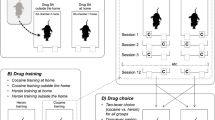Summary
Rats were induced to administer morphine to themselves by drinking solutions of it in preference to water; this behaviour was found to be a valid model of morphine dependence. Previous “passive” medication with morphine was not necessary; initial aversions for the bitter morphine solutions were converted into preferences after the rats were repeatedly given only morphine solutions to drink in order to relieve thirst. The consumption of solutions of quinine which were initially equally aversive did not increase, suggesting that the repeated pairing of a bitter taste with relief of thirst did not account for the preferences for the morphine solutions. It appeared that the post-ingestional effects of morphine provided primary reinforcement for the rats; they were able to regulate their daily intake of the drug after being injected with varying doses of it and they lost weight abruptly during enforced abstinence. There was also evidence that the bitter taste of morphine had become a secondary reinforcer for rats with established preferences.
Similar content being viewed by others
References
Akera, T., Brody, T. M.: The addiction cycle to narcotics in the rat and its relation to catecholamines. Biochem. Pharmacol. 17, 675–688 (1968).
Beach, H. D.: Morphine addiction in rats. Canad. J. Psychol. 11, 104–112 (1957).
Deneau, G. A.: Psychogenic dependence in monkeys, pp. 199–207. In: H. Steinberg (Ed.). Scientific Basis of Drug Dependence. London: Churchill 1969.
Garcia, J., Ervin, F. R.: Gustatory-visceral and telereceptor-cutaneous conditioning—adaptation in internal and external milieus. Comm. Behav. Biol., Part A 1, 389–415 (1968).
Jaffe, J. H.: Drug addiction and drug abuse, pp. 285–311. In: L. S. Goodman and A. Gilman (Eds.). The Pharmacological Basis of Therapeutics, 3rd ed. New York: Macmillan 1965.
Johnson, L. C., Lubin, A.: On planning psychophysiological experiments: design, measurement and analysis. In: N. S. Greenfield and R. A. Sternbach (Eds.): Handbook of Psychophysiology. New York-London: Holt, Rinehart and Winston, in press.
Kumar, R., Steinberg, H., Stolerman, I. P.: Inducing a preference for morphine in rats without premedication. Nature (Lond.) 218, 564–565 (1968).
— — —: How rats can become dependent on morphine in the course of relieving another need, pp. 209–220. In: H. Steinberg (Ed.): Scientific Basis of Drug Dependence. London: Churchill 1969.
Martin, W. R., Wikler, A., Eades, C. G., Pescor, F. T.: Tolerance to and physical dependence on morphine in rats. Psychopharmacologia (Berl.) 4, 247–260 (1963).
Nichols, J. R., Davis, W. M.: Drug addiction II. Variation of addiction. J. Amer. pharm. Ass., Sci. Ed. 48, 259–262 (1959).
Nichols, J. R., Headlee, C. P., Coppock, H. W.: Drug addition I. Addition by escape training. J. Amer. pharm. Ass. 45, 788–791 (1956).
Schuster, C. R., Thompson, T.: Self administration of and behavioral dependence on drugs. Ann. Rev. Pharmacol. 9, 483–502 (1969).
- Villarreal, J. E.: The experimental analysis of opioid dependence, pp. 811–828. In: D. H. Efron, J. O. Cole, J. Levine and J. R. Wittenborn (Eds.). Psychopharmacology: A review of progress, 1957–1967. U. S. Public Health Service Publication No. 1836 (1968).
—, Woods, J. H.: The conditioned reinforcing effects of stimuli associated with morphine reinforcement. Int. J. Addict. 3, 223–230 (1968).
Steinberg, H., Kumar, R., Kemp, I., Bartley, H.: Animal behaviour studies and some possible implications for man, pp. 29–40. In: C. W. M. Wilson (Ed.): Adolescent Drug Dependence. London: Pergamon 1968.
Thompson, T., Ostlund, W., Jr.: Susceptibility to readdiction as a function of the addiction and withdrawal environments. J. comp. physiol. Psychol. 60, 388–392 (1965).
—, Pickens, R.: Drug self-administration and conditioning, pp. 177–198. In: H. Steinberg (Ed.): Scientific Basis of Drug Dependence. London: Churchill 1969.
—, Schuster, C. R.: Morphine self-administration, food-reinforced and avoidance behaviours in rhesus monkeys. Psychopharmacologia (Berl.) 5, 87–94 (1964).
Way, E. L., Adler, T. K.: The pharmacologic implications of the fate of morphine and its surrogates. Pharmacol. Rev. 12, 383–446 (1960).
Weeks, J. R.: Experimental morphine addiction; method for automatic intravenous injections in unrestrained rats. Science 138, 143–144 (1962).
Wishart, J.: Growth-rate determinations in nutrition studies with the bacon pig, and their analyses. Biometrika 30, 16–28 (1938).
Woods, J. H., Schuster, C. R.: Reinforcement properties of morphine, cocaine and SPA as a function of unit dose. Int. J. Addict. 3, 231–237 (1968).
Wyrwicka, W.: Sensory regulation of food intake. Physiol. Behav. 4, 853–857 (1969).
Author information
Authors and Affiliations
Additional information
The work was supported by a grant from the Medical Research Council and by grant MH-03313 from the U.S. Public Health Service.
One of us (R. K.) held a Beit Memorial Research Fellowship.
Rights and permissions
About this article
Cite this article
Stolerman, I.P., Kumar, R. Preferences for morphine in rats: Validation of an experimental model of dependence. Psychopharmacologia 17, 137–150 (1970). https://doi.org/10.1007/BF00402704
Received:
Issue Date:
DOI: https://doi.org/10.1007/BF00402704




